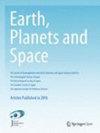嫦娥五号冲击玻璃微珠中铁含量的测定
IF 2.5
3区 地球科学
引用次数: 0
摘要
摘要月球表面和内部高度还原,导致铁离子几乎不存在。然而,最近的研究表明,在月球样品中存在铁,并且在大多数情况下,它们是在TEM-EELS测量的无定形硅酸盐(例如,玻璃珠)中发现的。本文对“嫦娥五号”撞击玻璃微珠的铁价态进行了系统的TEM-EELS分析。各硅酸盐玻璃样品的fe3 + /ΣFe比值由fe3和l2边缘的积分强度测定。测量结果表明,停留时间与fe3 + /ΣFe比值呈正相关,表明在常规分析条件下电子束轰击可以显著地产生三铁。在我们的“嫦娥五号”撞击玻璃微珠中计算出的停留时间短(≤20 ms)的Fe 3+ /ΣFe没有检测到固有的三铁,这表明三铁并不像之前报道的那样普遍存在。显然,仔细控制实验条件对于确定其他光束敏感的地面和地外样品的固有氧化还原状态至关重要。图形抽象本文章由计算机程序翻译,如有差异,请以英文原文为准。
Measurement of ferric iron in Chang’e-5 impact glass beads
Abstract The lunar surface and interior are highly reducing, resulting in the virtually absence of ferric ion. However, recent studies suggest the presence of ferric iron in lunar samples, and in most cases they were found in amorphous silicates (e.g., glass beads) measured by TEM–EELS. In this work, we conducted a systematic TEM–EELS analysis on the iron valence states of Chang’e-5 impact glass beads. The Fe 3+ /ΣFe ratio of each silicate glass sample was determined from integral intensity of Fe L 3 and L 2 edge. The measurements show a positive correlation between the dwell time and Fe 3+ /ΣFe ratio, which reveals that ferric iron can be significantly produced by electron beam bombardment under routine analytical condition. The calculated Fe 3+ /ΣFe with short dwell times (≤ 20 ms) in our Chang’e-5 impact glass beads show no detectable inherent ferric iron, suggesting that the ferric iron is not ubiquitous as previously reported. It is obvious that a careful control of experiment conditions is critical to determine the inherent redox state of other beam-sensitive terrestrial and extraterrestrial samples. Graphical Abstract
求助全文
通过发布文献求助,成功后即可免费获取论文全文。
去求助
来源期刊

Earth, Planets and Space
地学天文-地球科学综合
CiteScore
5.80
自引率
16.70%
发文量
167
期刊介绍:
Earth, Planets and Space (EPS) covers scientific articles in Earth and Planetary Sciences, particularly geomagnetism, aeronomy, space science, seismology, volcanology, geodesy, and planetary science. EPS also welcomes articles in new and interdisciplinary subjects, including instrumentations. Only new and original contents will be accepted for publication.
 求助内容:
求助内容: 应助结果提醒方式:
应助结果提醒方式:


